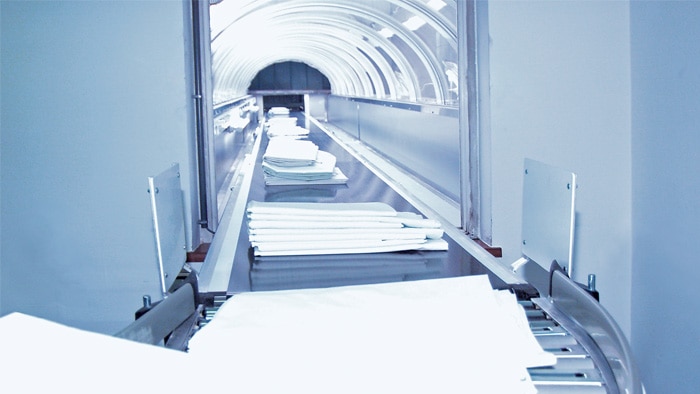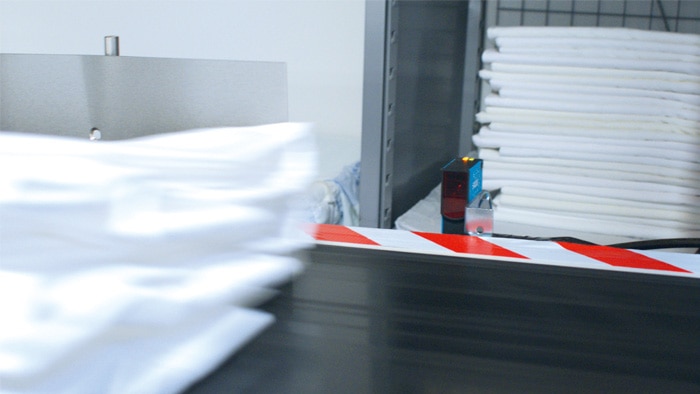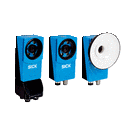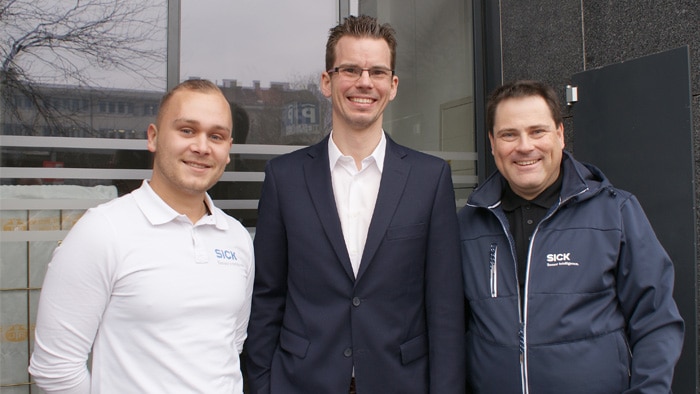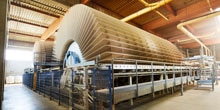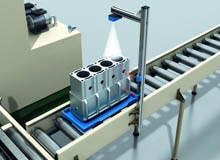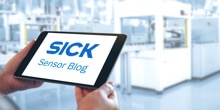The cleaning professionals at Rosa Toifl in Vienna make laundry shine again and bring a smile to customer’s faces. Tons of laundry are picked up, cleaned, dried and returned again each day. A logistical feat that is only possible thanks to state-of-the-art technology. Together with SICK, Rosa Toifl developed a tailored solution for sorting different textiles. The greatest challenge while doing so: not all hand towels are alike.
Tailored made sensor system for logistics with a clean effect
We all know the situation: towards the end of the week, the laundry bag can be literally up to its neck with dirty laundry. And that means work, combined with logistical finesse. Loading, washing, unloading, hanging up. Wash after wash – until everything is sparkling clean again. And then the real work begins: the ironing.
All this takes place on a very different scale in the professional area. This was revealed in our visit to the traditional Viennese business Rosa Toifl, the experts when it comes to clean hand towels, sheets, etc. Around 55 tons of laundry in total goes in and out of there each day. Or better put: dirty in and clean out. And that requires especially well organized work, i.e. a reliable technical solution. Getting the logistics and automation right is essential. That’s made possible by a 2D machine vision solution from SICK which sorts the laundry fully automatically. A real challenge, because the hand towels are similar but not exactly the same.
Caring for textiles for over 50 years
The company Toifl Textilpflege has dedicated itself to high quality cleaning and care of textiles of all kinds since 1954. “We set great store on careful handling, hygiene, and an immaculate appearance”, says the dyed-in-the-wool technician Jakob Müller-Hartburg, Executive Assistant at Rosa Toifl & Co. GmbH. We have a broad spectrum of customers, both in terms of textiles and industries. Our customers come, amongst other things, from hospitality, the hotel industry, or the hospital and health care sector.
Presorting, bag storage system, washing machines and dryers: the laundry goes on a journey
The processes on the four floors at Rosa Toifl are complex. The delivered laundry first needs to be transported to one of the top floors and presorted there into bags. These bags then go to a bag storage system, and at the appropriate time are automatically transported onwards into the washing machines. Once the laundry is clean again, it is transported to the dryers via a conveyor system. In the case of hand towels, these are dried fully and then unloaded automatically. Then they are folded and prepared for delivery. “All of these paths need to be ‘cleanly’ implemented, in the true sense of the word, both logistically and technically – floor by floor”, says Müller-Hartburg. Our total turnover per day is around 55 tons – an unbelievable amount of laundry that needs to be kept in motion. That’s why you see endless labyrinthine transport solutions here for transporting the laundry up and down through the building.
All in white
One of the greatest challenges is all the whiteness. Why: “The white laundry is a real challenge for automated sorting. Everything looks the same”, explains Jakob Müller-Hartburg. An efficient solution was needed – preferably fully automated. “We used to have a final location where all the laundry went to so that it could be sorted one more time before dispatch. But as the volume of orders increased, we began to run out of space to do this.”
Müller-Hartburg therefore set about finding a solution with the help of the specialists at SICK. They came up with an ingenious idea: “There are cameras that already detect all kinds of things. And if it is possible to scan surfaces, then this should also be possible with the structure of our goods. Namely, by checking the surface in detail”, says Müller-Hartburg. “A terry towel, for example, has a specific pattern, and is rougher and coarser than other textile surfaces.”
Intelligent image processing solution: let there be light
This pattern of the material structure provided the foundation for the intelligent image processing solution from SICK. “We will shine additional light on the laundry from an angle. This creates a shadow, based on which the irregularity of the surface can be identified as a clear pattern. The 2D image processing system can then quickly and reliably establish whether or not it is a terry towel, which will then determine what path the laundry item should take on the system.”, explains the expert at Rosa Toifl.
Inspector Vision Toolbox: a watchful eye
The easy to configure system was commissioned with the help of the free-of-charge, versatile SOPAS ET configuration software from SICK, which also delivers continuous real-time images to the operators. Particularly practical: the entire evaluation of the taught-in pattern occurs onboard the Inspector Vision Toolbox, which has been perfectly designed for high speed and fast switching operations. The versatile Vision Toolbox combines the performance of a 2D camera with the user-friendliness of an intelligent sensor without the need for additional hardware. It directly controls a valve, which in turn controls a pneumatic cylinder with a pusher. The Inspector is activated via a downstream photoelectric sensor. After classifying the shadow on the surface of the laundry stack, it issues a switching command to the valve if required. Depending on whether or not it is terry toweling, the stack is redirected at lightning speed by a pusher or otherwise not. In this way the material is sorted and transported to the correct area at the end of the cleaning process where it is prepared for dispatch. A perfect solution.
System reliability rather than rapidly growing mountains of laundry
With 55 tons of laundry per day, system reliability is especially important. If an area of the system fails for even a short time, the laundry quickly piles up immensely. And there’s not a lot of spare space around. “We need top quality components, reliable partners, and an exceptional team of technicians who can assist right away on-site”, says Müller-Hartburg, who believes in having as much expertise as possible in-house. He goes on: “We are very proud of this creative, joint solution. The flexibility and commitment of the SICK experts was fantastic. You could sense that they share our passion. The project was a real joy to work on. What a pity that it’s over, but we’ve already got some new ideas in the pipeline and the sensor systems from SICK are bound to be onboard again”.
